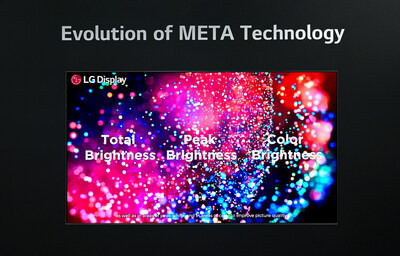LG Display Presents a New Era of OLED Picture Quality with 'META Technology 2.0' at CES 2024
With peak brightness being a crucial component of higher picture quality, 'META Technology 2.0' features
Last year, LG Display surpassed the limits of OLED picture quality with the unveiling of 'META Technology' after a decade of research and development in high-brightness technology, further widening its competitive advantage. Since then, LG Display has successfully developed 'META Technology 2.0' within a year to solidify its leadership in the field of OLED technology.
META Technology 2.0 comprises 'Micro Lens Array Plus (MLA+)' featuring a pattern of optimized micrometer-scale lenses, the upgraded brightness enhancing algorithm 'META Multi Booster,' and the full-range brightness detail enhancing algorithm 'Detail Enhancer,' which all combine to achieve a new maximum brightness of 3,000 nits, allowing the OLED panel to express the precise colors and brightness nature intended in any environment.
LG Display's 'Micro Lens Array' technology features a layer of micrometer-sized convex lenses. A total of 42.4 billion micro lenses (in a 77-inch 4K display) maximize light emission within the OLED panel to achieve revolutionary brightness. The process of creating billions of microscopic lenses in a pattern is extremely technically challenging.
Based on big data on MLA accumulated over the past year, MLA+ features an optimized lens angle that emits even the minimal light that would have been lost due to internal reflections. With an increased maximum brightness, OLED TV panels with META Technology 2.0 can more meticulously portray contrasts for a finer and more realistic viewing experience, from the immersive visuals of a cascading waterfall to the glimmers of individual droplets reflecting the sunlight.
Also referred to as 'Dragonfly Eye Technology,' MLA+ and its billions of micro-lenses create more accurate and detailed images with a wider viewing angle of 160 degrees, just as a dragonfly can see 360 degrees through millions of convex lenses.
'META Multi Booster', the company's exclusive brightness-optimizing algorithm, analyzes each scene in extreme detail to enhance not only peak brightness, a fundamental strength of LG Display OLEDs, but also color brightness for more refined and optimized picture quality.
By incorporating MLA+ and META Multi Booster, META Technology 2.0 achieves improved color brightness of up to 1,500 nits,
Furthermore, the strength of META Multi Booster is best demonstrated when depicting images with bright, vivid colors, such as the vibrant and diverse hues of auroras filling the night sky.
Displays typically struggle to accurately render darker images (low gradation) in contrast to brighter images (high gradation). LG Display's proprietary 'Detail Enhancer' is a full-range brightness detail enhancing algorithm that ensures consistent and accurate color expression regardless of brightness levels.
By incorporating a new data processing technique into OLED's 'Pixel Dimming' technology, which precisely controls the light of 33 million pixels (based on an 8K display) individually, Detail Enhancer allows the OLED panel to accurately convey unique colors as they were intended to be seen. When depicting dark underwater scenes, viewers can experience the distinct colors and details of a tropical fish without distortion.
OLED's self-emissive structure allows each pixel to emit light independently without a backlight unit, which unlocks an infinite contrast ratio and extremely vibrant and precise color expression. LG Display's OLED TV panel based on META Technology enhances energy efficiency by
LG Display unveiled its 83-inch OLED TV panel featuring META Technology 2.0 for the first time at CES 2024. As demand for ultra-large TVs continues to increase, the company plans to apply META Technology 2.0 to its lineup of large-sized and ultra-large OLED TV panels, including the 55-, 65-, 77-, and 83-inch 4K OLEDs and the 77- and 88-inch 8K OLEDs, to further strengthen its OLED leadership in the global premium TV market.
"META Technology 2.0 represents the pinnacle of displays after surpassing the limitations and boundaries of OLED to create the perfect harmony between humans, nature, and the environment," said Hyeon-woo Lee, Senior Vice President and Head of Large Display Business Unit at LG Display. "We will firmly establish our technological edge in the OLED TV panel market with the latest evolution of our META Technology."
About LG Display
LG Display Co., Ltd. [NYSE: LPL, KRX: 034220] is the world's leading innovator of display technologies, including thin-film transistor liquid crystal and OLED displays. The company manufactures display panels in a broad range of sizes and specifications primarily for use in TVs, notebook computers, desktop monitors, automobiles, and various other applications, including tablets and mobile devices. LG Display currently operates manufacturing facilities in
Media Contact:
Joo Yeon Jennifer Ha, Manager, Communication Team
Email: hjy05@lgdisplay.com
![]() View original content to download multimedia:https://www.prnewswire.com/news-releases/lg-display-presents-a-new-era-of-oled-picture-quality-with-meta-technology-2-0-at-ces-2024--302028329.html
View original content to download multimedia:https://www.prnewswire.com/news-releases/lg-display-presents-a-new-era-of-oled-picture-quality-with-meta-technology-2-0-at-ces-2024--302028329.html
SOURCE LG Display








